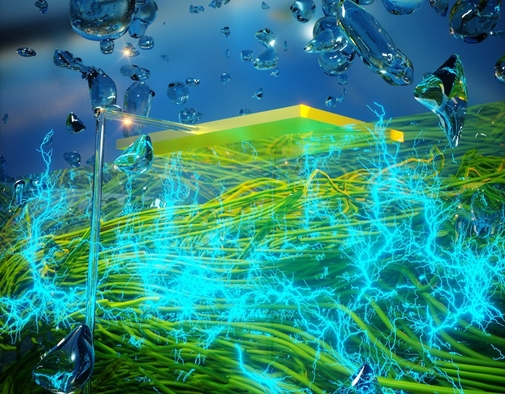|
NOVIDADES
Scientists in the US claim to have developed a device that can generate electricity from moisture in the air. The device, based around a thin film of electrically conductive protein nanowires, can produce continuous electrical power for around 20 h, before self-recharging. The researchers say that such technology could provide clean energy without the restrictions on location and environmental conditions of other renewable energy solutions such as solar cells (Nature 10.1038/s41586-020-2010-9).  Graphic image of a thin film of protein nanowires generating electricity from atmospheric humidity. Courtesy: UMass Amherst/Yao and Lovley labs
Jun Yao, an electrical engineer at the University of Massachusetts, and his colleagues found that this set-up was able to produce a continuous current for more than 20 h. After 20 h, the voltage had dropped from around 0.5 V to 0.35 V, but when the load was removed, it went back up to 0.5 V within five hours, showing a self-recharging process. The researchers also connected multiple devices together to increase the output. With 17 devices they were able to generate 10 V, and demonstrated that these connected devices could power an LED or a small liquid crystal display. G. sulfurreducens was discovered by Derek Lovley, a microbiologist at the University of Massachusetts. He tells Physics World that the bacteria use the electrically conductive nanowires to make connections with other microbial species and with minerals. “For example, in soils and sediments, Geobacter feeds electrons to methane-producing microorganisms, which use the electrons to convert carbon dioxide to methane,” Lovley says. “Geobacter also electrically connects to iron minerals in soils and sediments to use iron minerals similarly to how we use oxygen.” Yao tells Physics World that the way the device works can be compared with lightning. “The cloud builds up positive and negative charges at the upper and lower sides, and upon a certain threshold, it discharges through the lightening,” he explains. “This indicates that charge can be built up from the ambient environment and we may be able to harvest it for electricity production. One can think of our device to be a small cloud, with one side open to air and the other sealed. Water molecules in the air constantly bump into the open surface, creating more charges than on the other one. The charge difference eventually will build up electric field or potential difference, which will drive the electric current output.” The team experimentally determined that ambient humidity was the source of energy by sealing the top of the device, to block water-molecule exchange with the nanowires. This cut the electrical output, which returned once the seal was removed. They also found that increasing the ambient humidity, and thus the water-molecule exchange rate, increased the electric output. To check that there were no electrochemical reactions with the gold plates, the team replaced them with inert carbon electrodes, and were able to generate similar voltages. The device also worked in the dark, eliminating a photovoltaic effect. Yao says that the researchers are now working on connecting devices together to increase the power volume. “We have demonstrated that the devices can be connected to increase the power, so at a certain point, it is proven this will scale,” he says. “We are working on material sciences and engineering strategies to scale up the technology.” By Michael Allen.PhysicsWorld: Posted: Apr 03, 2020.
|
|||||||||||||||||||||||||